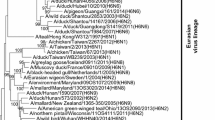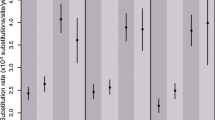Abstract
Avian influenza virus (AIV) prevalence and sequence data were analyzed for Steller’s eiders (Polysticta stelleri) to assess the role of this species in transporting virus genes between continents and maintaining a regional viral reservoir with sympatric northern pintails (Anas acuta). AIV prevalence was 0.2% at Izembek Lagoon and 3.9% at Nelson Lagoon for Steller’s eiders and 11.2% for northern pintails at Izembek Lagoon. Phylogenetic analysis of 13 AIVs from Steller’s eiders revealed that 4.9% of genes were of Eurasian origin. Seven subtypes were detected, including two also observed in northern pintails. No AIV strains were highly similar (> 99%) at all gene segments between species; however, highly similar individual genes were detected. The proportion of highly similar genes was greater within rather than between species. Steller’s eiders likely transport AIV genes between continents through long-distance migratory movements. Differences in AIV prevalence, subtype distribution, and the proportion of highly similar genes suggest limited AIV exchange between Steller’s eiders and northern pintails at Alaska Peninsula coastal lagoons during autumn.







Similar content being viewed by others
References
Ip HS, Flint PL, Franson JC, Dusek RJ, Derksen DV, Gill RE, Ely CR, Pearce JM, Lanctot RB, Matsuoka SM, Irons DB, Fischer JB, Oates RM, Petersen MR, Fondell TF, Rocque DA, Pedersen JC, Rothe TC (2008) Prevalence of influenza A viruses in wild migratory birds in Alaska: patterns of variation in detection at a crossroads of intercontinental flyways. Virol J 5:71
Jahangir A, Watanabe Y, Chinen O, Yamazaki S, Sakai K, Okamura M, Nakamura M, Takehara K (2008) Surveillance of avian influenza viruses in Northern Pintails (Anas acuta) in Tohoku District, Japan. Avian Dis 52:49–53
Haynes L, Arzey E, Bell C, Buchanan N, Burgess G, Cronan V, Dickason C, Field H, Gibbs S, Hansbro PM, Hollingsworth T, Hurt AC, Kirkland P, McCracken H, O’Connor J, Tracey J, Wallner J, Warner S, Woods R, Bunn C (2009) Australian surveillance for avian influenza viruses in wild birds between July 2005 and June 2007. Aust Vet J 87:266–272
Hesterberg U, Harris K, Stroud D, Guberti V, Busani L, Pittman M, Piazza V, Cook A, Brown I (2009) Avian influenza surveillance in wild birds in the European Union in 2006. Influenza Other Respi Viruses 3:1–14
Chen R, Holmes EC (2009) Frequent inter-species transmission and geographic subdivision in avian influenza viruses from wild birds. Virology 383:156–161
Ramey AM, Pearce JM, Ely CR, Sheffield Guy LM, Irons DB, Derksen DV, Ip HS (2010) Transmission and reassortment of avian influenza viruses at the Asian-North American interface. Virology 406:352–359
Kawaoka Y, Chambers TM, Sladen WL, Webster RG (1988) Is the gene pool of influenza viruses in shorebirds and gulls different from that in wild ducks? Virology 163:247–250
Fouchier RAM, Munster V, Wallensten A, Bestebroer TM, Herfst S, Smith D, Rimmelzwaan GF, Olsen B, Osterhaus ADME (2005) Characterization of a novel influenza A virus hemagglutinin subtype (H16) obtained from Black-headed Gulls. J Virol 79:2814–2822
Olsen B, Munster VJ, Wallensten A, Waldenström J, Osterhaus ADME, Fouchier RAM (2006) Global patterns of influenza A virus in wild birds. Science 312:384–388
Wille M, Robertson GJ, Whitney H, Ojkic D, Lang AS (2010) Reassortment of American and Eurasian genes in an influenza A virus isolated from a Great Black-backed Gull (Larus marinus), a species demonstrated to move between these regions. Arch Virol 156:107–115
Granter A, Wille M, Whitney H, Robertson GJ, Ojkic D, Lang AS (2010) The genome sequence of an H11N2 avian influenza virus from a Thick-billed Murre (Uria lomvia) shows marine-specific and regional patterns of relationships to other viruses. Virus Genes 41:224–230
Livezey BC (1995) Phylogeny and evolutionary ecology of modern seaducks (Anatidae: Mergini). Condor 97:233–255
Livezey BC (1991) A phylogenetic analysis and classification of recent dabbling ducks (tribe Anatini) based on comparative morphology. Auk 108:471–507
Dau CP, Flint PF, Petersen MR (2000) Distribution of recoveries of Steller’s Eiders banded on the lower Alaska Peninsula, Alaska. J Field Ornithol 71:541–548
Flint PL, Ozaki K, Pearce JM, Guzzetti B, Higuchi H, Fleskes JP, Shimada T, Derksen DV (2009) Breeding-season sympatry facilitates genetic exchange among allopatric wintering populations of Northern Pintails in Japan and California. Condor 111:591–598
Jones RD Jr (1965) Returns of Steller’s Eiders banded in Izembek Bay, Alaska. Wildfowl 16:83–85
Petersen MR (1981) Populations, feeding ecology and molt of Steller’s Eiders. Condor 83:256–262
Petersen MR (1980) Observations of wing-feather moult and summer feeding ecology of Steller’s Eiders at Nelson Lagoon, Alaska. Wildfowl 31:99–106
Flint PL, Petersen MR, Dau CP, Hines JE, Nichols JD (2000) Annual survival and site fidelity of Steller’s Eiders molting along the Alaska Peninsula. J Wild Manage 64:261–268
Spackman E, Senne DA, Myers TJ, Bulaga LL, Garber LP, Perdue ML, Lohman K, Daum LT, Suraez DL (2002) Development of a real-time reverse transcriptase PCR assay for type A influenza virus and the avian H5 and H7 hemagglutinin subtypes. J Clin Microbiol 40:3256–3260
Senne DA (1989) Virus propagation in embryonating eggs. In: Purchase HG, Arp LH, Domermuth CH, Pearson JE (eds) A laboratory manual for the isolation and identification of avian pathogens, 3rd edn. Kendall/Hunt, Dubuque, pp 176–181
Ramey AM, Pearce JM, Flint PL, Ip HS, Derksen DV, Franson JC, Petrula MJ, Scotton BD, Sowl KM, Wege ML, Trust KA (2010) Intercontinental reassortment and genomic variation of low pathogenic avian influenza viruses isolated from Northern Pintails (Anas acuta) in Alaska: Examining the evidence through space and time. Virology 401:179–189
Pearce JM, Reeves AB, Ramey AM, Hupp JW, Ip HS, Bertram M, Petrula MJ, Scotton BD, Trust KA, Meixell BW, Runstadler JA (2011) Interspecific exchange of avian influenza virus genes in Alaska: the influence of trans-hemispheric migratory tendency and breeding ground sympatry. Mol Ecol 20:1015–1025
Tamura K, Dudley J, Nei M, Kumar S (2007) MEGA4: Molecular Evolutionary Genetics Analysis (MEGA) software version 4.0. Mol Biol Evol 24:1596–1599
Ronquist F, Huelsenbeck JP (2003) MRBAYES 3: Bayesian phylogenetic inference under mixed models. Bioinformatics 19:1572–1574
Bahl J, Vijaykrishna D, Holmes EC, Smith GJD, Guan Y (2009) Gene flow and competitive exclusion of avian influenza A virus in natural reservoir hosts. Virology 390:289–297
Miller MR, Takekawa JY, Fleskes JP, Orthmeyer DL, Casazza ML, Perry WM (2005) Spring migration of Northern Pintails from Calfornia’s Central Valley wintering area tracked with satellite telemetry: routes, timing, and destinations. Can J Zool 83:1314–1332
Krauss S, Obert CA, Franks J, Walker D, Jones K, Seiler P, Niles L, Pryor SP, Obenauer JC, Naeve CW, Widjaja L, Webby RJ, Webster RG (2007) Influenza in migratory birds and evidence of limited intercontinental virus exchange. PloS Pathog 3:1684–1693
Kleijn D, Munster VJ, Ebbinge BS, Jonkers DA, Müskens GJDM, Van Randen Y, Fouchier RAM (2010) Dynamics and ecological consequences of avian influenza virus infection in Greater White-fronted Geese in their winter staging areas. Proc R Soc B 277:2041–2048
Brown JD, Goekjian G, Poulson R, Valeika S, Stallknecht DE (2009) Avian influenza virus in water: Infectivity is dependent on pH, salinity, and temperature. Vet Microbiol 136:20–26
Ito T, Okazaki K, Kawaoka Y, Takada A, Webster RG, Kida H (1995) Perpetuation of influenza A viruses in Alaska waterfowl reservoirs. Arch Virol 140:1163–1172
Hollmén TE, Franson JC, Flint PL, Grand JB, Lanctot RB, Docherty DE, Wilson HM (2003) An adenovirus linked to mortality and disease in Long-tailed Ducks (Clangula hyemalis) in Alaska. Avian Dis 47:1434–1440
Delogu M, DeMarco MA, Di Trani L, Raffini E, Cotti C, Puzelli S, Ostanello F, Webster RG, Cassone A, Donatelli I (2010) Can preening contribute to influenza A virus infection in wild waterbirds? PLoS One 5:e11315
Acknowledgments
We thank T. Bowman (U.S. Fish and Wildlife Service; USFWS), K. Sowl (USFWS), and members of USFWS field crews for sampling Steller’s eiders during banding drives at Nelson and Izembek Lagoons. We are grateful to D. Derksen (U.S. Geological Survey; USGS), T. DeGange (USGS), S. Haseltine (USGS), L. Allen (USGS), R. Kearney (USGS), P. Bright (USGS), D. Rocque (USFWS), and K. Trust (USFWS) for financial and administrative support. We thank past and current members of the Diagnostic Virology Laboratory at the USGS National Wildlife Health Center, including T. Egstad, K. Griffin, M. Houfe, and R. Long. We acknowledge Y. Gillies (USGS), J. Wiley (USGS), M. St. Peters (USFWS), D. Goldberg (USGS), and R. Zane (USGS) for coordinating the distribution of sampling materials, receipt of samples, and data verification. We thank P. Flint (USGS) for assistance with statistical analyses and J. Terenzi (USGS) for help with the creation of Fig. 1. B. Meixell (USGS), J. Brown (University of Georgia), and two anonymous reviewers provided comments on an earlier version of this manuscript. None of the authors have any financial interests or conflict of interest with this article. Any use of trade names is for descriptive purposes only and does not imply endorsement by the U.S. Government.
Author information
Authors and Affiliations
Corresponding author
Electronic supplementary material
Below is the link to the electronic supplementary material.
Rights and permissions
About this article
Cite this article
Ramey, A.M., Pearce, J.M., Reeves, A.B. et al. Evidence for limited exchange of avian influenza viruses between seaducks and dabbling ducks at Alaska Peninsula coastal lagoons. Arch Virol 156, 1813–1821 (2011). https://doi.org/10.1007/s00705-011-1059-z
Received:
Accepted:
Published:
Issue Date:
DOI: https://doi.org/10.1007/s00705-011-1059-z




